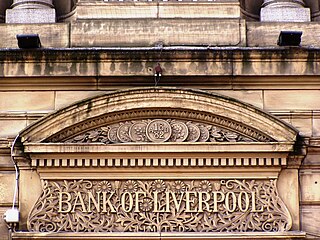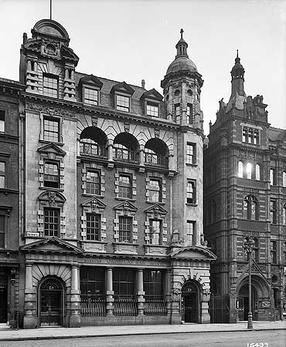
NatWest Group plc is a British banking and insurance holding company, based in Edinburgh, Scotland. The group operates a wide variety of banking brands offering personal and business banking, private banking, investment banking, insurance and corporate finance. In the United Kingdom, its main subsidiary companies are National Westminster Bank, Royal Bank of Scotland, NatWest Markets and Coutts. The group issues banknotes in Scotland and Northern Ireland; as of 2014, the Royal Bank of Scotland was the only bank in the UK to continue to print £1 notes.

Westminster Bank was a British retail bank which operated in England and Wales. It was created in 1834 as the London and Westminster Bank. It merged with the London and County Bank in 1909, after which it renamed itself the London County and Westminster Bank, then acquired the former business of Birkbeck Bank in 1911, Ulster Bank in 1917, and Parr's Bank in 1918, following which it changed its name again to London County Westminster and Parrs. It shortened its name to Westminster Bank in 1923.

Coutts & Co. is a British private bank and wealth manager headquartered in London, England.

The Bank of Liverpool was a financial institution founded in 1831 in Liverpool, England.

The Royal Bank of Scotland plc is a major retail and commercial bank in Scotland. It is one of the retail banking subsidiaries of NatWest Group, together with NatWest and Ulster Bank. The Royal Bank of Scotland has around 700 branches, mainly in Scotland, though there are branches in many larger towns and cities throughout England and Wales. The bank is completely separate from the fellow Edinburgh-based bank, the Bank of Scotland, which pre-dates the Royal Bank by 32 years. The Royal Bank of Scotland was established to provide a bank with strong Hanoverian and Whig ties.

Messrs Drummond is a formerly independent private bank in the United Kingdom that is now part of NatWest Group. The Royal Bank of Scotland incorporating Messrs Drummond, Bankers is based at 49 Charing Cross in central London. Drummonds is authorised as a brand of The Royal Bank of Scotland by the Prudential Regulation Authority.

The historic overseas bank was established in London in 1828 as Leslie & Grindlay, agents and bankers to the British army and business community in India. Banking operations expanded to include the Indian subcontinent, the Middle East and elements of Africa and Southeast Asia. It was styled Grindlay, Christian & Matthews in 1839, Grindlay & Co from 1843, Grindlay & Co Ltd from 1924 and Grindlays Bank Ltd in 1947 until its merger with the National Bank of India.
The Isle of Man Bank is a bank in the British Crown dependency of the Isle of Man, providing retail, private and business banking services to the local population. Incorporated in 1865, it has operated as a trading name of RBS International since 2019. It is licensed by the Isle of Man Financial Services Authority in respect of deposit taking and investment business and registered as a general insurance intermediary.

The Manchester and Liverpool District Bank was formed in 1829 and it became one of the leading provincial joint stock banks; its name was shortened to District Bank in 1924. The Bank was acquired by the National Provincial Bank in 1962 but kept its identity until the latter’s merger with Westminster Bank.

Parr's Bank Limited was a bank that existed from 1782 to 1918. It was founded as Parr & Co. in Warrington, then in the county of Lancashire in the United Kingdom. In 1918 it was acquired by London County and Westminster Bank, and it was thus one of the predecessors of NatWest Group.

Thomas Joplin (1790?–1847) was an English timber merchant and banker, resident in Newcastle upon Tyne, notable as an early and persistent promoter of the concept of the joint stock bank.
Williams & Glyn's Bank Limited was established in London in 1970, when the Royal Bank of Scotland merged its two subsidiaries in England and Wales, Williams Deacon's Bank Ltd. and Glyn, Mills & Co. In 1985, Williams & Glyn's was fully absorbed into the Royal Bank of Scotland and ceased to trade separately.

National Westminster Bank, commonly known as NatWest, is a major retail and commercial bank in the United Kingdom based in London, England. It was established in 1968 by the merger of National Provincial Bank and Westminster Bank. In 2000, it became part of The Royal Bank of Scotland Group, which was re-named NatWest Group in 2020. Following ringfencing of the group's core domestic business, the bank became a direct subsidiary of NatWest Holdings; NatWest Markets comprises the non-ringfenced investment banking arm. The British government currently owns 39% of NatWest Group after spending £45 billion bailing out the lender in 2008; the proportion at one point was 54.7%. NatWest International is a trading name of RBS International, which also sits outside the ringfence.

International Westminster Bank was a wholly-owned subsidiary of National Westminster Bank and its predecessors from 1913 to 1989, with branches in London, France, Spain and West Germany.
The National Commercial Bank of Scotland Ltd. was a Scottish commercial bank. It was established in 1959 through a merger of the National Bank of Scotland with the Commercial Bank of Scotland. Ten years later it merged with the Royal Bank of Scotland, to become the largest clearing bank in Scotland. The National Commercial Bank issued its own banknotes.
Lloyds Bank International is a wholly owned subsidiary of Lloyds Bank Corporate Markets in the United Kingdom, which is in turn part of Lloyds Banking Group, one of the largest banking groups in Europe.
National Westminster Bank USA, commonly known as NatWest USA, was a wholly owned subsidiary of National Westminster Bank in the United Kingdom from 1983 to 1996. Formed as the National Bank of North America in 1905, the U.S. retail banking operation was sold to Fleet Financial Group in 1996.
Holt's Military Banking is a trading name of The Royal Bank of Scotland, a subsidiary of NatWest Group, offering dedicated banking facilities to service personnel in the United Kingdom and on operational tours of duty overseas. It can trace its origins to a Mr. Vesey, army agent to the 23rd Regiment of (Light) Dragoons, in Dublin in 1802.

NatWest Markets is the investment banking arm of NatWest Group based in the United Kingdom.
Fuller, Banbury, Nix & Co was a British private bank based in the City of London. It was founded in 1737 in Lombard Street, London and operated under a succession of names reflecting its different partners until receiving its final name in 1881. One of the bank's partners, John Hennings Nix, was the second great-grandfather of Alexander Nix. The bank had a seat on the London Bankers' Clearing House. In 1891 the bank was acquired by Parr's Banking Co Ltd of Warrington, thus facilitating the bank's expansion into London. Through merger with London County & Westminster Bank in 1918, it became a constituent part of the modern NatWest.


















